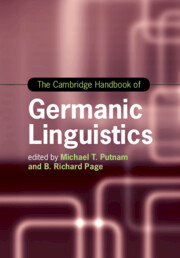Book contents
- The Cambridge Handbook of Germanic Linguistics
- Cambridge Handbooks in Language and Linguistics
- The Cambridge Handbook of Germanic Linguistics
- Copyright page
- Contents
- Figures
- Maps
- Tables
- Contributors
- Acknowledgments
- Germanic Languages
- Part I Phonology
- Part II Morphology and Agreement Systems
- Chapter 9 Verbal Inflectional Morphology in Germanic
- Chapter 10 Inflectional Morphology
- Chapter 11 Principles of Word Formation
- Chapter 12 Grammatical Gender in Modern Germanic Languages
- Chapter 13 Case in Germanic
- Chapter 14 Complementizer Agreement
- Part III Syntax
- Part IV Semantics and Pragmatics
- Part V Language Contact and Nonstandard Varieties
- Index
- References
Chapter 11 - Principles of Word Formation
from Part II - Morphology and Agreement Systems
Published online by Cambridge University Press: 31 March 2020
- The Cambridge Handbook of Germanic Linguistics
- Cambridge Handbooks in Language and Linguistics
- The Cambridge Handbook of Germanic Linguistics
- Copyright page
- Contents
- Figures
- Maps
- Tables
- Contributors
- Acknowledgments
- Germanic Languages
- Part I Phonology
- Part II Morphology and Agreement Systems
- Chapter 9 Verbal Inflectional Morphology in Germanic
- Chapter 10 Inflectional Morphology
- Chapter 11 Principles of Word Formation
- Chapter 12 Grammatical Gender in Modern Germanic Languages
- Chapter 13 Case in Germanic
- Chapter 14 Complementizer Agreement
- Part III Syntax
- Part IV Semantics and Pragmatics
- Part V Language Contact and Nonstandard Varieties
- Index
- References
Summary
Word formation in Germanic languages mainly takes place by means of compounding and affixation. Compounds are usually right-headed, and there is often a linking element in N+N-compounds that derives historically from a case ending. In addition to endocentric compounds there are also copulative compounds. Compounding also takes place with roots of Greek and Latin origin that do not occur as words by themselves. Some compound constituents have developed into affixoids. Affixation is used to derive words of major categories: nouns, verbs, adjectives, and adverbs. Some of these affixes behave phonologically similar to compound constituents. Many nonnative affixes, identified on the basis of sets of borrowed nonnative complex words, are being used in word formation as well. Other mechanisms of word formation are affix substitution, conversion, reduplication, prosodic morphology, abbreviation, and blending. For the construction of numerals above 20, syntactic coordination may be used. The word formation patterns of Germanic languages have been strongly influenced by contact with Greek, Latin, and French. In addition, they have been influenced by contact with English. Individual languages have borrowed some of their morphology and complex words from another Germanic language, and Yiddish has been strongly influenced by various non-Germanic languages.
Keywords
- Type
- Chapter
- Information
- The Cambridge Handbook of Germanic Linguistics , pp. 238 - 258Publisher: Cambridge University PressPrint publication year: 2020
References
- 1
- Cited by

